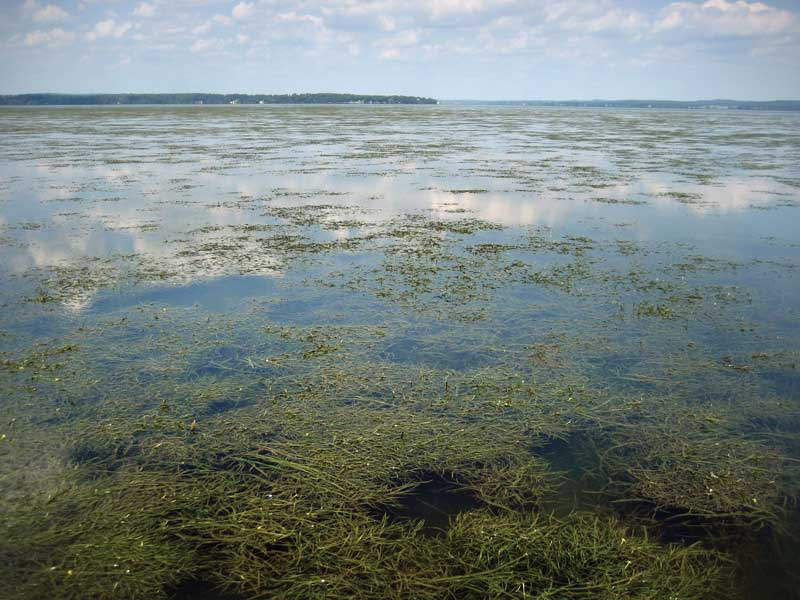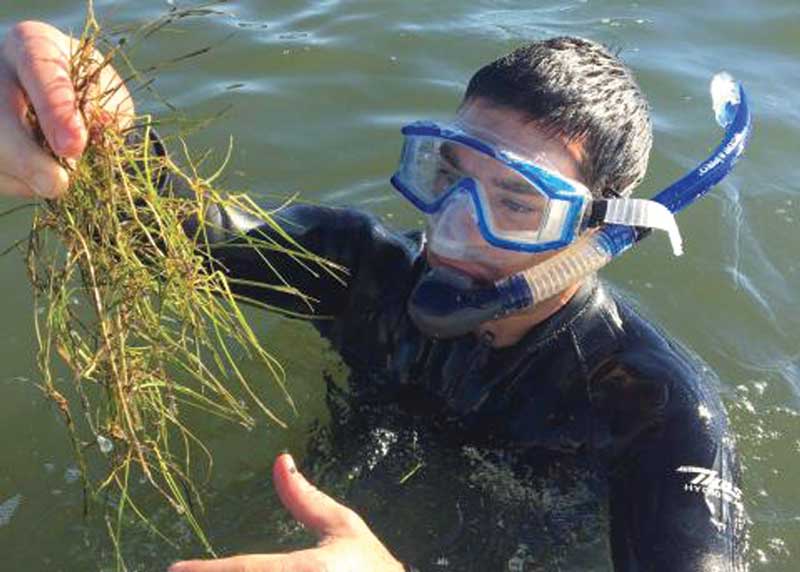Scientists have discovered that the recent comeback of underwater grasses in the Chesapeake Bay not only removes nutrient pollution, improves water clarity, and provides habitat for baby crabs and rockfish, but may also offset the growing problem of acidification as climate change impacts the nation’s largest estuary.

Ocean acidification is a phenomenon driven by the increasing levels of carbon dioxide in the atmosphere because of the burning of fossil fuels and other human-driven activities. When ocean and estuarine waters absorb this additional carbon dioxide from the atmosphere, the waters can become more acidic. Shellfish build their shells out of a compound in the water known as calcium carbonate, and scientists have found there will be less of those building blocks available as ocean carbon dioxide levels rise.
“Many researchers have shown how submerged aquatic vegetation, or SAV, can locally reinforce their own growth by slowing water flow and allowing particles to settle out of the water to allow more light,” said study co-author Jeremy Testa, associate professor at the University of Maryland Center for Environmental Science.
“This new research suggests that SAV can provide additional ecosystem benefits—buffering water against acidification—far beyond the habitats where they grow. The SAV-driven pH-buffering mechanism is an unanticipated benefit of restoring SAV through nutrient management efforts.”
Underwater grasses, or SAV, are essential to the Bay ecosystem. They pull harmful nutrients out of the water, cause sediments to settle to the bottom so sunlight can reach plants, protect the shoreline by reducing the impact of waves and currents, and provide habitat and food for a host of important organisms, including baby crabs.

While there was a Bay-wide decline of SAV from the 1960s through the 1980s, restoring these once-abundant beds has been a primary outcome of efforts to reduce loads of nutrients and sediments to the estuary. SAV cover has increased by 300 percent from 1984 to 2015. One of the largest recovered SAV beds lies in an area of the bay known as the Susquehanna Flats: a broad, tidal freshwater region located near the mouth of the Susquehanna River at the head of the Bay. Today it is one of the biggest and healthiest in the Bay, spanning some 20 square miles.
In a recent study, a team of researchers were drawn to the Susquehanna Flats SAV bed to solve a puzzle of Chesapeake Bay chemistry. The researchers found that SAV beds were sites of production for an acid-reducing compound called calcium carbonate. It was discovered that strong photosynthesis by the plants in Susquehanna flats SAV beds at the head of the Bay and in other shallow, nearshore waters can remove nutrient pollution and generate very high pH, which facilitates the formation of calcium carbonate minerals. When these calcium carbonate particles and other biologically produced carbonate shells are transported downstream, they enter acidic subsurface waters where they dissolve. The team found the carbonate particles reduced the acidity of the water by four times than it otherwise might have been.
One question critical for this buffer mechanism is whether the calcium carbonate minerals can escape trapping in the estuarine turbidity maximum zone and be transported downstream. A numerical model was used to show that the small crystallites formed on the SAV beds can indeed be transported to the mid-Bay where they dissolve in acidic subsurface waters.
“Just like people take Tums to neutralize the acids that cause heartburn, SAV beds send carbonate minerals to the lower Bay to neutralize acids there,” said Testa, who worked with faculty research assistant Casey Hodgkins and University of Delaware researchers to make the SAV bed measurements.
The implication is that the SAV beds can potentially help to make deeper Bay waters more hospitable to shell-forming organisms.
A globally eminent research and graduate institution focused on advancing scientific knowledge of the environment, the University of Maryland Center for Environmental Science provides sound advice to help state and national leaders manage the environment and prepares future scientists to meet the global challenges of the 21st century.